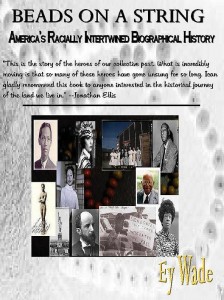 Today we have a sneak peek of Ey Wade’s creative non-fiction book, Beads On a String-America’s Racially Intertwined Biographical History:
Today we have a sneak peek of Ey Wade’s creative non-fiction book, Beads On a String-America’s Racially Intertwined Biographical History:
History was written in more than Black & White and Beads on a String-America’s Racially Intertwined Biographical History lauds loudly the accomplishments of all races that helped make America the great country it has become. America’s glorious multi-racial history is finally acknowledged and bound into one book.
Beads On a String-America’s Racially Intertwined Biographical History is available at Amazon.com, Amazon UK, Smashwords, iTunes, and Barnes & Noble.
And now, from Beads On a String-America’s Racially Intertwined Biographical History:
The Purpose of This Book
As a homeschooling parent it came across the mind of my youngest daughter to ask about a history book which talks about all the races within its bounded pages. She is a born optimist and hates the way we as adults seem to enjoy racial profiling. I as the mother and her instructor in life wanted to give her what she wanted, but I could find none. So, as a home-school project we decided to write our own, Beads on a String-America’s Racially Intertwined Biographical History.
America has had great contributors within every century working hard together and yet each race would like to pull out their certain pages and categorize them into their own history book. And we truly believe if someone has a problem with our choice they would have to deal with it or well, get over it. Our main focus is to try and eliminate the division of a great nation by a single line, the hyphenation.
America as a nation has many problems and yet what other country in the world can attest to the fact that people or dying to be here? There is a dream in their heart to be a part of this great nation and to live in the land of good and plenty as a member of one body. So why do we keep the line of separation as a constant reminder? The hyphenation: at tiny line which separates all races and the word American.
Beads on a String- America’s Racially Intertwined Biographical History chooses not to be about a certain color, but about a certain nation, America.
It is time for America to let go of the past and heal itself. The grieving period should have been over and the healing started. But every year, old wounds are torn open by the words Black History Month. Why don’t we teach the children about America’s History with everyone included? To me it seems as if only a few Black people are pulled out of the closet, dusted off the shelves and paraded in front of America as if to say, ‘this one wasn’t worthless’, this one wasn’t stupid’. Why is the ‘black’ in capital letters? Is it to point out a person of color has a brain or is it to pronounce to the world we have pride? If there is so much pride in America for Native, African, Chinese, Japanese, Indian, Iranian-Americans and other ‘hyphened Americans, drop the hyphen and pull together and teach our children that every bead has a purpose and should be celebrated.
______________________________[subscribe2]


RE: The hyphenation: that tiny line which separates all races and the word American.
Native Americans were given a pass on this but, yes, I do agree that the hyphen places a great divide between groups. Before that designation, though, we were American Indians, a term some still prefer.
Ah, that we could all just "be".
And here we use the term First Nations. What do Native Americans south of the border think of that term, I'm curious?
I agree with you. I think the separation makes it harder for us to be ONE nation. There is nothing wrong with being proud of your good Irish, African, Japanese or whatever kind of Roots….but deep down we are supposed to be One nation and if you don't believe that then you are perhaps living in the wrong place. Maybe if we need a special day….make it a Be Proud Of your Heritage Day and then EVERYONE can take part. That would glorify our ancestors of ALL races rather than picking out the chosen few….
We don't use the hyphen in Canada but the divisions are there just the same. This sounds like a great undertaking.
It would be awesome if we could just 'be' and not try to make a point of keeping the difference as a barrier.
Yes, Yvonne it was a challenge collecting and separating info, but such fun. I learned so much.
You mean you have fun learning? TWO THUMBS UP!!! I hear you!!! Great. Thanks for sharing. Promoting this on my FB pg.
Ciao for now,
Carole
Lol, without a doubt. That's one of the reasons I decided to home-school. Everyday I learn some fantastic things.
We are slowly improving. I live in a very multi-cultural area and my three year old daughter has never even questioned why some people have different pigmentation, accents, etc. She just accepts that everyone is unique. Great post and ideas, thank you.
My girls were the same until they entered traditional school. Not long after entering kindergarten my daughter came home saying 'this brown girl, and this white girl.' I told her not to talk to me about the children until she learned their names.
Yeah, the future all depends on how new generations of kids are taught and raised. Not to be colour-blind, necessarily (although that is the long term ideal), but to understand the history of how we got to where we are and therefore how much further we need to go. I say "we", as I think this is bigger than just the United States, or even North America, this is a global issue.
Too true. Thanks for stopping by, David.